A launch is the final step in a transportation analysis. Here, the
barge is trimmed to a fairly large angle (2.5, 3 degrees, or more),
the seafastenings are cut, and the jacket slides off the barge and
into the water. The purpose of a launch analysis is to make sure
that all of this occurs in a semi-controlled manner. The figure
below shows a launch of a normal jacket.
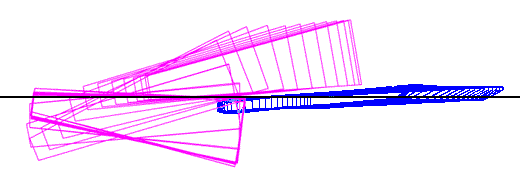
Not all jackets behave like this, however. Sometimes one designs
a jacket so that it will not float horizontally, but instead upends
itself during the launch process. The trajectory of this type of jacket
is
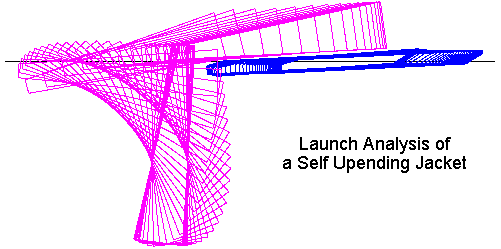 Now, to make sense of the process, we need to take a closer look
at a few "events" during the process. First, let us consider the
situation at the beginning of the launch.
Now, to make sense of the process, we need to take a closer look
at a few "events" during the process. First, let us consider the
situation at the beginning of the launch.
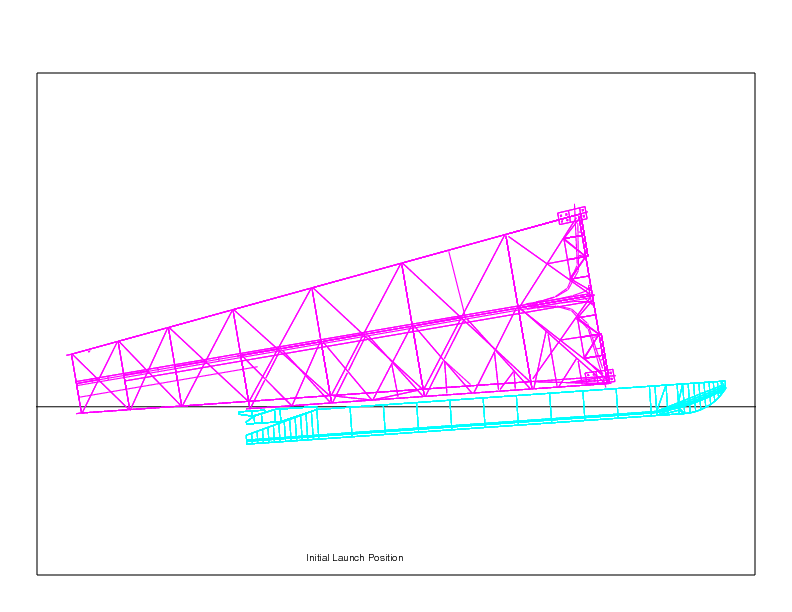 Here, you can clearly see that the barge trim is quite large - 4
degrees and that the tilt beam is completely submerged. While
neither of these conditions is necessary, one normally finds that
this yields the optimal launch. (More will be said about this later.)
Here, you can clearly see that the barge trim is quite large - 4
degrees and that the tilt beam is completely submerged. While
neither of these conditions is necessary, one normally finds that
this yields the optimal launch. (More will be said about this later.)
From the starting point, the jacket is either winched or it
slides along the barge for some time until it "tips".
 Here, the trailing edge of the jacket comes off of the barge skidway
and the tilt beams rotate along with the jacket. After tipping, the
jacket rotates and slides until it separates from the barge.
Here, the trailing edge of the jacket comes off of the barge skidway
and the tilt beams rotate along with the jacket. After tipping, the
jacket rotates and slides until it separates from the barge.
 The jacket, freed from the barge, oscillates a few times and comes to
rest.
The jacket, freed from the barge, oscillates a few times and comes to
rest.
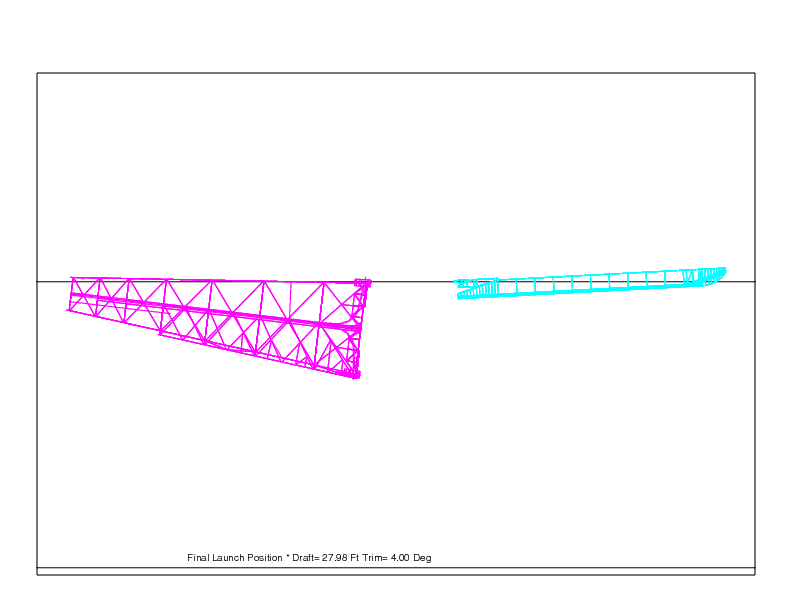 The important thing here is that one wants the jacket to float with
the face of the jacket at the water surface. If the final jacket
position is too different from this, it will not be very stable.
The important thing here is that one wants the jacket to float with
the face of the jacket at the water surface. If the final jacket
position is too different from this, it will not be very stable.
Now, let us turn our attention to a few technical factors. During
the launch several things are happening, but the most important is
that the forces the barge applies to the jacket change dramatically.
In particular, let us suppose that the force system acting on the
jacket is represented as two forces at the rocker pin and two forces
at the trailing edges of the launch legs. At the beginning, the forces
at the trailing edge have some value and they decrease from there.
In contrast, the ones at the rocker pins begin at some value and
increase. Here is the plot of the true temporal behavior.
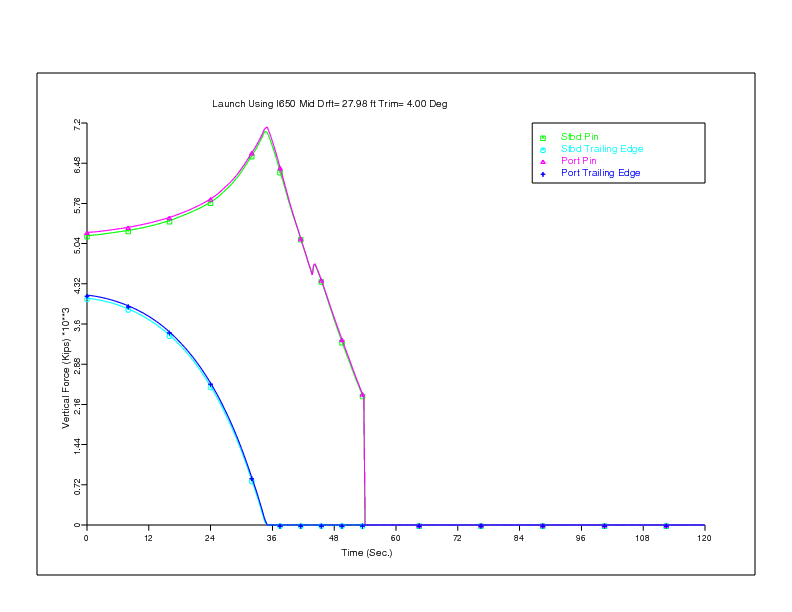 Notice two things about this plot. First, the reaction at the trailing
edge goes to zero at some time. This is the time when the jacket "tips".
Second, and more importantly, the rocker pin reactions are a maximum
at the same time! It is the maximum rocker reaction which we use as
a measure of goodness in a launch because you must put steel into
the jacket to withstand this reaction and the steel will be of no
value once the jacket is installed. i.e. this is wasted steel.
Notice two things about this plot. First, the reaction at the trailing
edge goes to zero at some time. This is the time when the jacket "tips".
Second, and more importantly, the rocker pin reactions are a maximum
at the same time! It is the maximum rocker reaction which we use as
a measure of goodness in a launch because you must put steel into
the jacket to withstand this reaction and the steel will be of no
value once the jacket is installed. i.e. this is wasted steel.
We said above that launches normally start out at a large angle,
and now we are in a position to see why. The way to minimize the
maximum rocker reaction is to have the "most jacket buoyancy" as
possible at tip. To do this, we need to both have the stern
of the barge as deep in the water as possible and have the jacket
at as large an angle as possible when tipping occurs. Now, why do
we not carry this process further? There are three factors which limit
the draft and trim that can be used for a launch. First, there is
a the question of stability. Notice that during the tipping phase
the barge has very little waterplane area. When the angle gets too
large, the barge will lose stability and this is definitely not good.
The second limiting factor is the design head of the barge stern.
In our case here, the barge stern is down at around 40 feet. The barge
better be designed to cope with this head, or it will not like the
results. The final limiting factor is the strength of the barge
itself. At tipping, the barge looks like a cantilever beam with a
span of about 2/3 of the barge length. It better have enough steel
in it to carry this moment.
Now, what else can go wrong during a launch? Perhaps one of the
most obvious is that the jacket could impact the bottom. Thus, it is
always a good idea to look at the plot
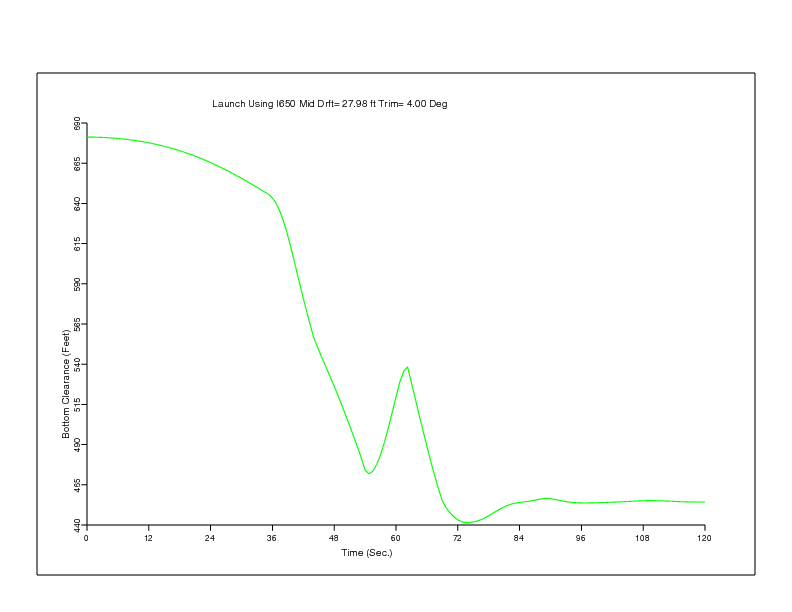 which shows the distance between the bottom and the jacket during the
launch. This curve is quite typical in that there are normally two
relative minima: one for the "top" of the jacket and another for
the bottom. With deep water structures as we have here, there is
not a problem, but for shallow waters, this can be critical. The
other area of concern is best demonstrated with another picture:
which shows the distance between the bottom and the jacket during the
launch. This curve is quite typical in that there are normally two
relative minima: one for the "top" of the jacket and another for
the bottom. With deep water structures as we have here, there is
not a problem, but for shallow waters, this can be critical. The
other area of concern is best demonstrated with another picture:
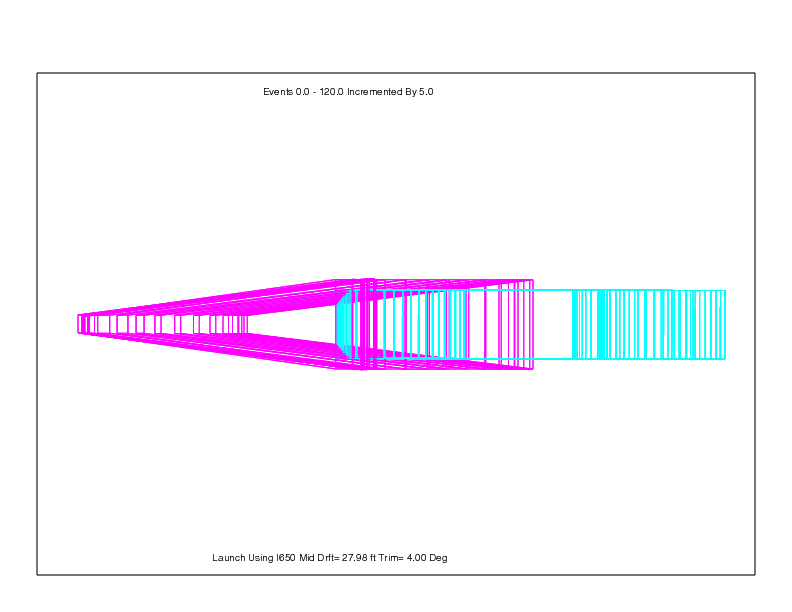 This shows the top view during the launch. Notice that the jacket and
barge both travel in a line in this view. This is what one wants!
If there is relative yaw between the two bodies, many bad things can
happen. Relative yaw will occur if the jacket center of gravity is
substantially off of its centerline. When this happens, you can
move the barge skidway so that the cg of the jacket lies on the
barge centerline, or add something to the jacket to even the
weight distribution.
This shows the top view during the launch. Notice that the jacket and
barge both travel in a line in this view. This is what one wants!
If there is relative yaw between the two bodies, many bad things can
happen. Relative yaw will occur if the jacket center of gravity is
substantially off of its centerline. When this happens, you can
move the barge skidway so that the cg of the jacket lies on the
barge centerline, or add something to the jacket to even the
weight distribution.









